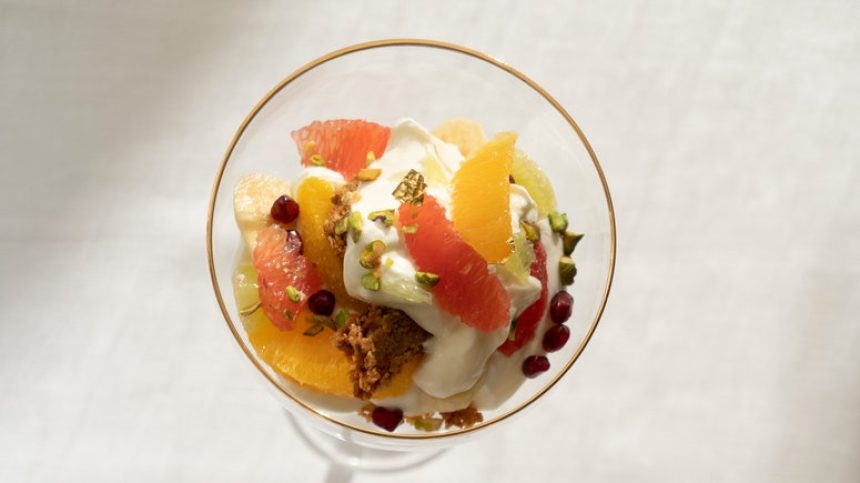At the heart of the Mediterranean diet is seasonal eating, with the freshest ingredients that come from as close to the land and sea as possible. There isn’t a strict definition of Mediterranean eating, but rather, a template that’s based on the traditional foods of the countries around the Mediterranean, including Jordan, Syria, Lebanon and Egypt. There are staple foods that underpin the traditional meals in each of these countries:
- Fresh fruit and vegetables, such as cucumbers, bell peppers, tomatoes, aubergine, courgettes, artichokes, olives, figs, lemons, pomegranates, dates, and cherries
- Extra virgin olive oil made from local olive trees
- Nuts and seeds, such as almonds, pistachios, walnuts, sesame seeds, pumpkin seeds and cashews
- Pulses and legumes, such as chickpeas, lentils, fava beans and butter beans
- Fish and seafood, such as squid, prawns, octopus, sardines, cod, and sea bream
- Dairy products and eggs, including Greek yoghurt, labneh and feta
- Lean meats and poultry
- Fresh and dried herbs and spices, such as oregano, za’atar, sumac, basil including sea salt
These foods are particularly rich in antioxidants, the nutritional compounds that improve skin health and brain function, protect against chronic disease and support the immune system. The traditional food in the Mediterranean diet is also a rich source of vitamins and minerals, as well as heart-friendly omega-3 fatty acids, which are associated with lower cardiovascular risk.
What should you not eat on a Mediterranean diet?
The abundance and variety intrinsic to the Mediterranean diet means that meals are about addition rather than restriction. This eating pattern moves away from the calorie counting and food group elimination of many quick fix diets and focuses on eating plenty of locally sourced, nutrient dense foods. Because of the Mediterranean diet’s emphasis on fresh, brightly coloured and seasonal produce, ultra processed foods, trans-fats and added sugars are not typically included within this way of eating.
What would a typical Mediterranean breakfast look like?
For all the abundance in the Mediterranean diet, breakfast isn’t a meal that tends to feature highly. The first meal of the day tends to be quite light, with coffee, freshly baked bread, seasonal fruits, yoghurt, and eggs, all prepared in local style. In Italy, you might have toast with soft cheese, freshly squeezed juices and fresh fruit, whereas as in Morocco, you might have fried eggs in olive oil with fresh bread, olives and labneh or in Greece, you would typically have bread, Greek yoghurt with honey, feta, fresh fruit and of course, Greek coffee.
Here are a few Mediterranean themed recipes if you’d like to make your own Med breakfast.
What would a typical Mediterranean lunch look like?
A typical Mediterranean lunch is quite light and flavourful, featuring fresh, seasonal vegetables, often prepared in salads like tabbouleh or fattoush, fish or seafood, lean proteins like chicken, whole grains like bulgur, rice or bread such as freshly baked pita and of course, extra virgin olive oil.
You might have a French soup like Bouillabaisse, a Greek salad with thick slices of feta and fresh tomatoes, olives and red onions or a piece of just caught fish with local vegetables and dips like baba ghanoush, hummus or tzatziki on the side. Lunches are focused on easy to digest, fresh and well-seasoned ingredients that are satisfying, providing lots of energy without leaving you feeling sluggish, even on the hottest of days.
Try your own Mediterranean lunch with these recipes:
What would a typical Mediterranean dinner look like?
Dinner is typically eaten later in the evening in Mediterranean countries due to the heat. They usually include red meat, fish or seafood as the main course and of course, plenty of fresh, seasonal vegetables. Because evening meals are most often shared with family and friends, you might see larger cuts of meat such as a leg or shoulder of lamb, a whole fish or tagines and stews that can be easily passed around among a large group of people. Vegetables, legumes and pulses and grains like farro or couscous would feature amongst the side dishes that accompany the main meal.
Serve up your own Mediterranean dinner with these recipes:








